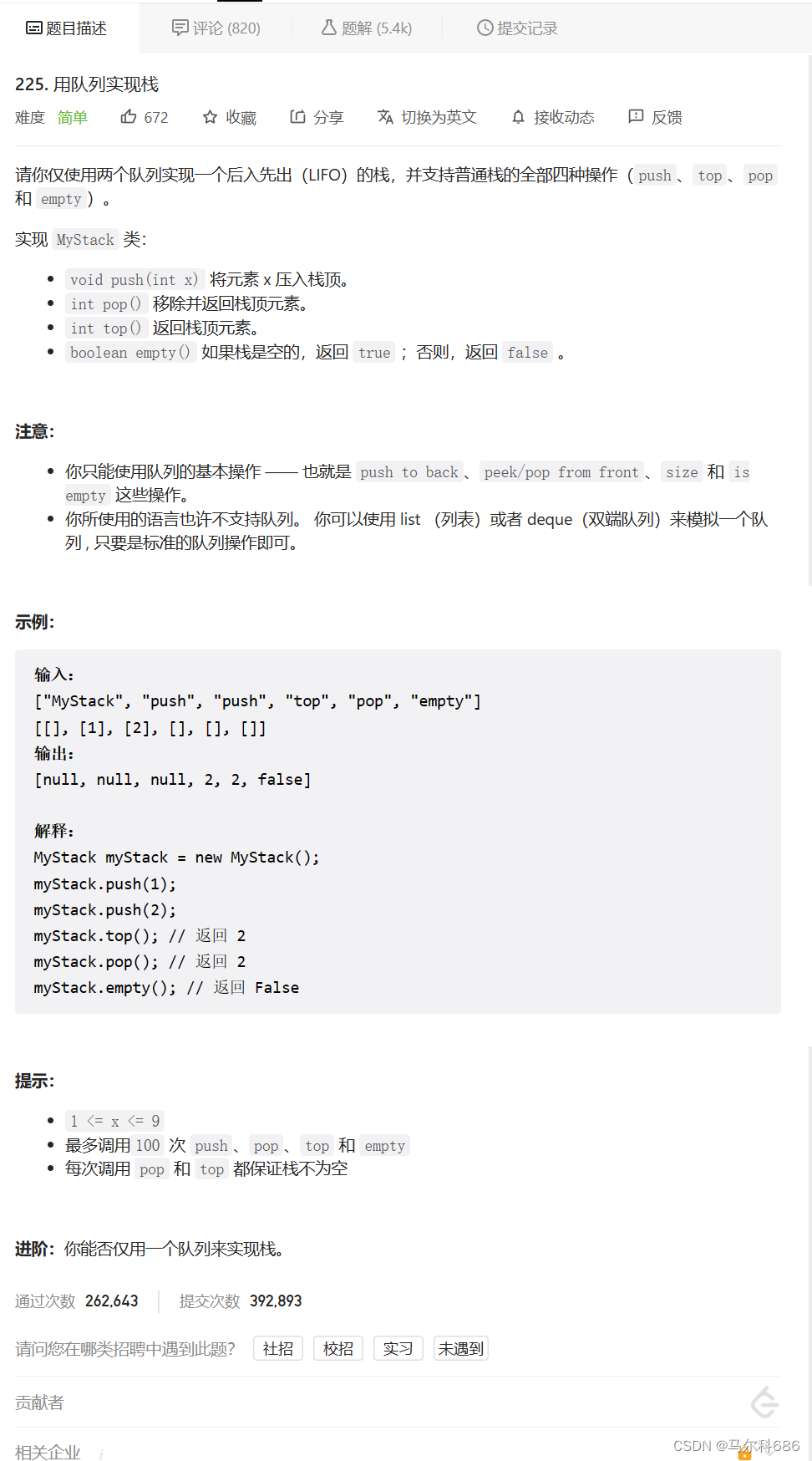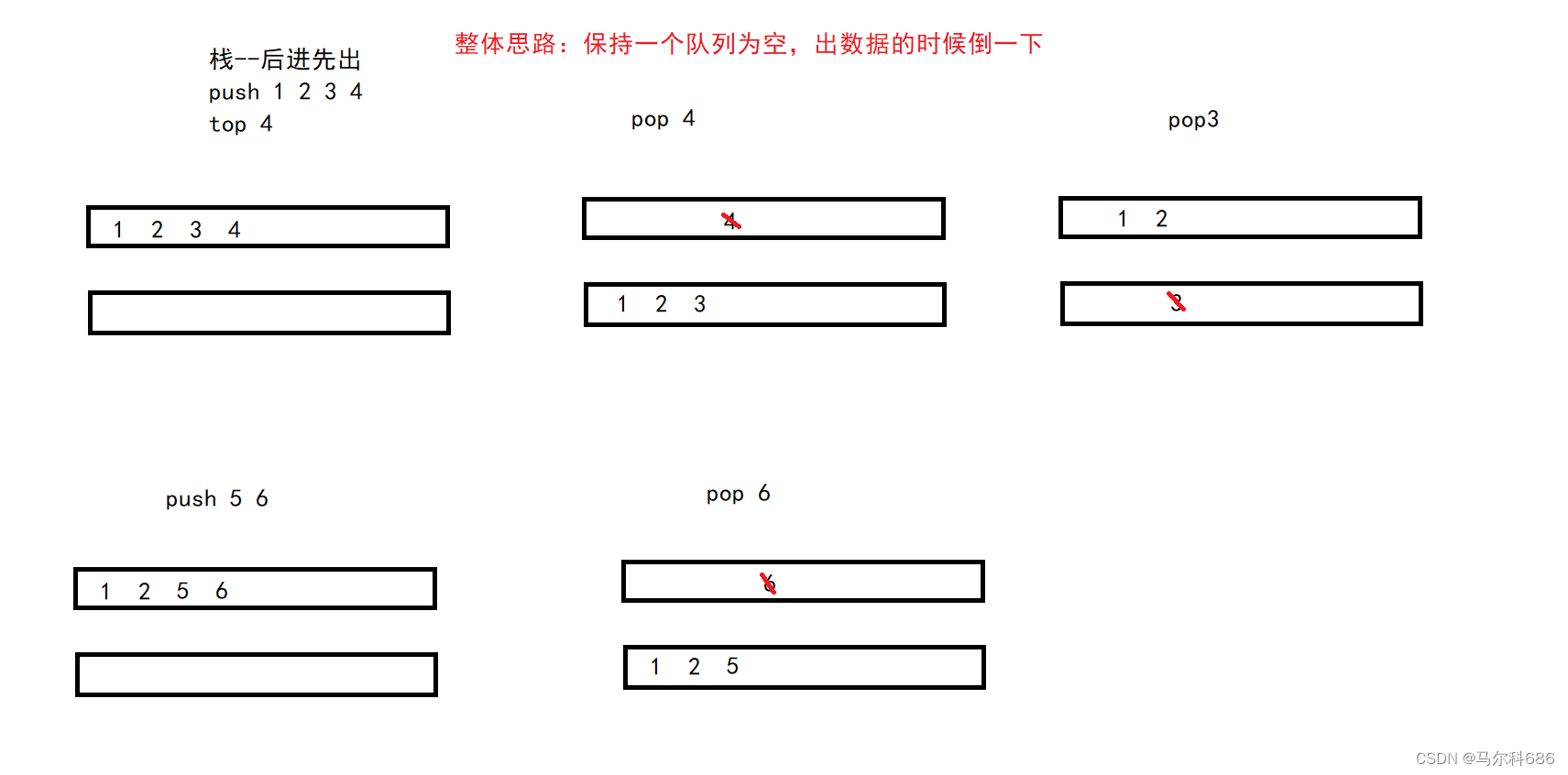【数据结构】栈和队列

文章目录
- 前言
- 一、栈
-
- 1.1 栈的概念结构
- 1.2栈的实现
- 二、队列
-
- 2.1队列的概念及结构
- 2.2队列的实现
- 三、栈和队列面试题
- 总结
前言
一、栈
1.1 栈的概念结构
栈也是一种线性表,数据在逻辑上挨着存储。只允许在固定的一端进行插入和删除元素。进行插入和删除操作的一端叫栈顶,另一端叫栈底。符合LIFO 先进后出。
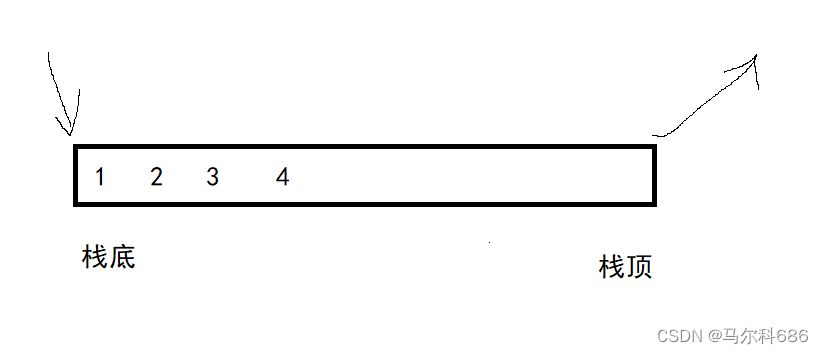
压栈:插入操作。
出栈:删除操作。
1.2栈的实现
栈的实现用数组实现更好,因为完美符合数组的尾插尾删。
数组的缓存利用率高一点。

小练习:
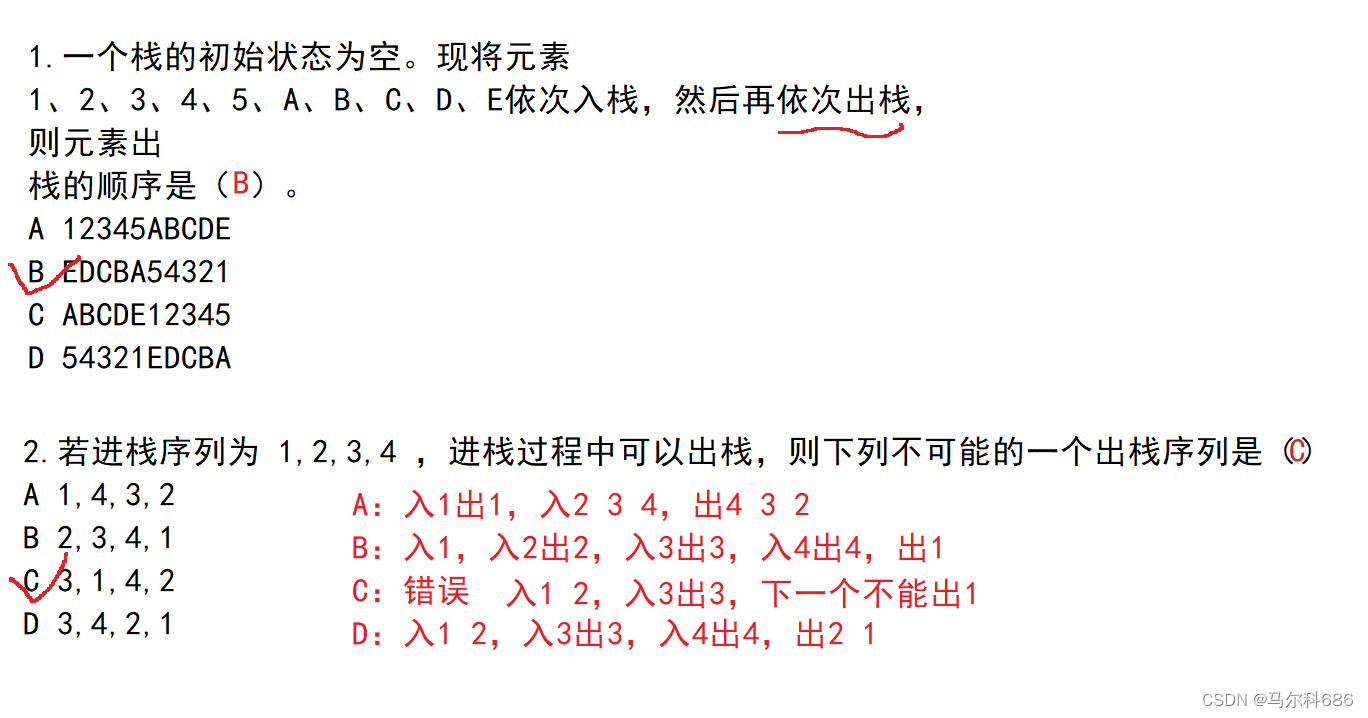
支持动态增长的栈:
typedef int STDataType;
typedef struct Stack
{STDataType* _a;int _top; // 栈顶int _capacity; // 容量
}Stack;
初始化栈:
void StackInit(ST* ps)
{assert(ps);ps->a = NULL;ps->top = ps->capacity = 0;
}
入栈:进栈(栈的插入操作),若栈未满,则将x加入使之成为新栈顶。
void StackPush(ST* ps, STDataType x)
{assert(ps);if (ps->top == ps->capacity){int newCapacity = ps->capacity == 0 ? 4 : ps->capacity * 2;STDataType* tmp = (STDataType*)realloc(ps->a, newCapacity * sizeof(STDataType));if (tmp == NULL){perror("realloc fail");exit(-1);}ps->a = tmp;ps->capacity = newCapacity;}ps->a[ps->top] = x;ps->top++;
}
出栈:出栈(栈的删除操作),若栈非空,则弹出栈顶元素,并用x返回。
void StackPop(ST* ps)
{assert(ps);assert(!StackEmpty(ps));--ps->top;
}
获取栈顶元素:
STDataType StackTop(ST* ps)
{assert(ps);assert(!StackEmpty(ps));return ps->a[ps->top - 1];
}获取栈中有效元素个数:
int StackSize(ST* ps)
{assert(ps);return ps->top;
}
销毁栈:栈销毁,并释放占用的存储空间
void StackDestroy(ST* ps)
{assert(ps);free(ps->a);ps->a = NULL;ps->capacity = ps->top = 0;
}
检测栈是否为空,如果为空返回非零结果,如果不为空返回0:
bool StackEmpty(ST* ps)
{assert(ps);return ps->top == 0;
}
Stack.h
#pragma once
#include<stdio.h>
#include<stdlib.h>
#include<assert.h>
#include<stdbool.h>
typedef int STDataType;
typedef struct Stack
{STDataType* a;int top;int capacity;
}ST;void StackInit(ST* ps);
void StackDestroy(ST* ps);
void StackPush(ST* ps, STDataType x);
void StackPop(ST* ps);
STDataType StackTop(ST* ps);
bool StackEmpty(ST* ps);
int StackSize(ST* ps);
Stack.c
#include "Stack.h"void StackInit(ST* ps)
{assert(ps);ps->a = NULL;ps->top = ps->capacity = 0;
}void StackDestroy(ST* ps)
{assert(ps);free(ps->a);ps->a = NULL;ps->capacity = ps->top = 0;
}void StackPush(ST* ps, STDataType x)
{assert(ps);if (ps->top == ps->capacity){int newCapacity = ps->capacity == 0 ? 4 : ps->capacity * 2;STDataType* tmp = (STDataType*)realloc(ps->a, newCapacity * sizeof(STDataType));if (tmp == NULL){perror("realloc fail");exit(-1);}ps->a = tmp;ps->capacity = newCapacity;}ps->a[ps->top] = x;ps->top++;
}void StackPop(ST* ps)
{assert(ps);assert(!StackEmpty(ps));--ps->top;
}STDataType StackTop(ST* ps)
{assert(ps);assert(!StackEmpty(ps));return ps->a[ps->top - 1];
}bool StackEmpty(ST* ps)
{assert(ps);return ps->top == 0;
}int StackSize(ST* ps)
{assert(ps);return ps->top;
}
二、队列
2.1队列的概念及结构
队列:只允许在一端进行插入数据操作,在另一端进行删除数据操作的特殊线性表,队列具有先进先出FIFO(First In First Out)
入队列:进行插入操作的一端称为队尾。
出队列:进行删除操作的一端称为队头。
2.2队列的实现
队列用链表的结构实现更优
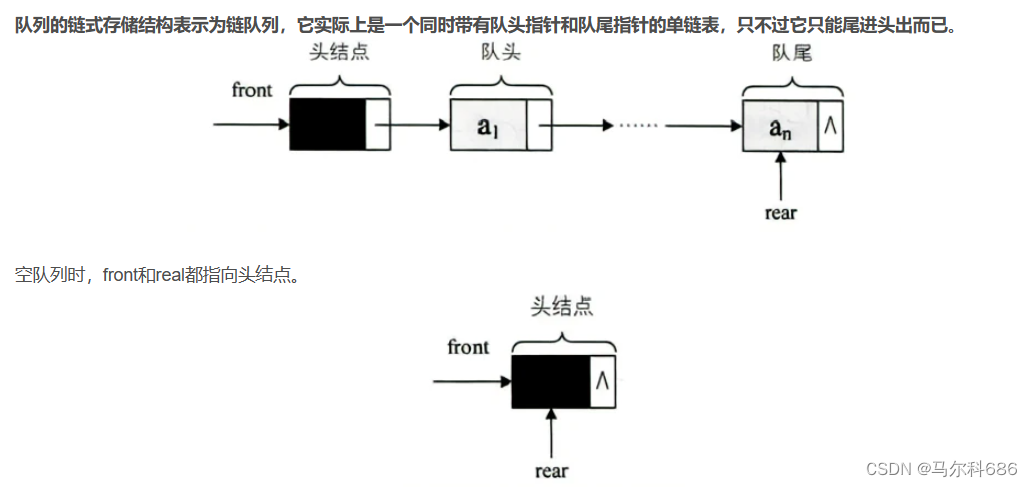
链式结构:表示队列
typedef struct QListNode
{ struct QListNode* _pNext; QDataType _data;
}QNode;
队列的结构:
typedef struct Queue
{QNode* head;QNode* tail;int size;
}Queue;
初始化队列:
void QueueInit(Queue* pq)
{assert(pq);pq->head = pq->tail = NULL;pq->size = 0;
}
队尾入队列:
void QueuePush(Queue* pq, QDataType x)
{assert(pq);QNode* newnode = (QNode*)malloc(sizeof(QNode));if (newnode == NULL){perror("malloc fail");exit(-1);}else{newnode->data = x;newnode->next = NULL;}if (pq->tail == NULL){pq->head = pq->tail = newnode;}else{pq->tail->next = newnode;pq->tail = newnode;}pq->size++;
}
队头出队列:
void QueuePop(Queue* pq)
{assert(pq);assert(!QueueEmpty(pq));if (pq->head->next == NULL){free(pq->head);pq->head = pq->tail = NULL;}else{QNode* del = pq->head;pq->head = pq->head->next;free(del);del = NULL;}pq->size--;
}获取队列头部元素:
QDataType QueueFront(Queue* pq)
{assert(pq);assert(!QueueEmpty(pq));return pq->head->data;
}
获取队列队尾元素:
QDataType QueueBack(Queue* pq)
{assert(pq);assert(!QueueEmpty(pq));return pq->tail->data;
}
获取队列中有效元素个数:
int QueueSize(Queue* pq)
{assert(pq);return pq->size;
}
检测队列是否为空,如果为空返回非零结果,如果非空返回0:
bool QueueEmpty(Queue* pq)
{assert(pq);return pq->head == NULL && pq->tail == NULL;
}
销毁队列:
void QueueDestroy(Queue* pq)
{assert(pq);QNode* cur = pq->head;while (cur){QNode* del = cur;cur = cur->next;free(del);}pq->head = pq->tail = NULL;
}
Queue.h
#pragma once
#include <stdio.h>
#include<stdlib.h>
#include<assert.h>
#include<stdbool.h>typedef int QDataType;
typedef struct QueueNode
{struct QueueNode* next;QDataType data;
}QNode;typedef struct Queue
{QNode* head;QNode* tail;int size;
}Queue;void QueueInit(Queue* pq);
void QueueDestroy(Queue* pq);
void QueuePush(Queue* pq, QDataType x);
QDataType QueueFront(Queue* pq);
QDataType QueueBack(Queue* pq);
bool QueueEmpty(Queue* pq);
int QueueSize(Queue* pq);
Queue.c
#include"Queue.h"void QueueInit(Queue* pq)
{assert(pq);pq->head = pq->tail = NULL;pq->size = 0;
}void QueueDestroy(Queue* pq)
{assert(pq);QNode* cur = pq->head;while (cur){QNode* del = cur;cur = cur->next;free(del);}pq->head = pq->tail = NULL;
}void QueuePush(Queue* pq, QDataType x)
{assert(pq);QNode* newnode = (QNode*)malloc(sizeof(QNode));if (newnode == NULL){perror("malloc fail");exit(-1);}else{newnode->data = x;newnode->next = NULL;}if (pq->tail == NULL){pq->head = pq->tail = newnode;}else{pq->tail->next = newnode;pq->tail = newnode;}pq->size++;
}void QueuePop(Queue* pq)
{assert(pq);assert(!QueueEmpty(pq));if (pq->head->next == NULL){free(pq->head);pq->head = pq->tail = NULL;}else{QNode* del = pq->head;pq->head = pq->head->next;free(del);del = NULL;}pq->size--;
}QDataType QueueFront(Queue* pq)
{assert(pq);assert(!QueueEmpty(pq));return pq->head->data;
}QDataType QueueBack(Queue* pq)
{assert(pq);assert(!QueueEmpty(pq));return pq->tail->data;
}bool QueueEmpty(Queue* pq)
{assert(pq);return pq->head == NULL && pq->tail == NULL;
}int QueueSize(Queue* pq)
{assert(pq);return pq->size;
}
三、栈和队列面试题
题目链接:
1.https://leetcode.cn/problems/valid-parentheses/
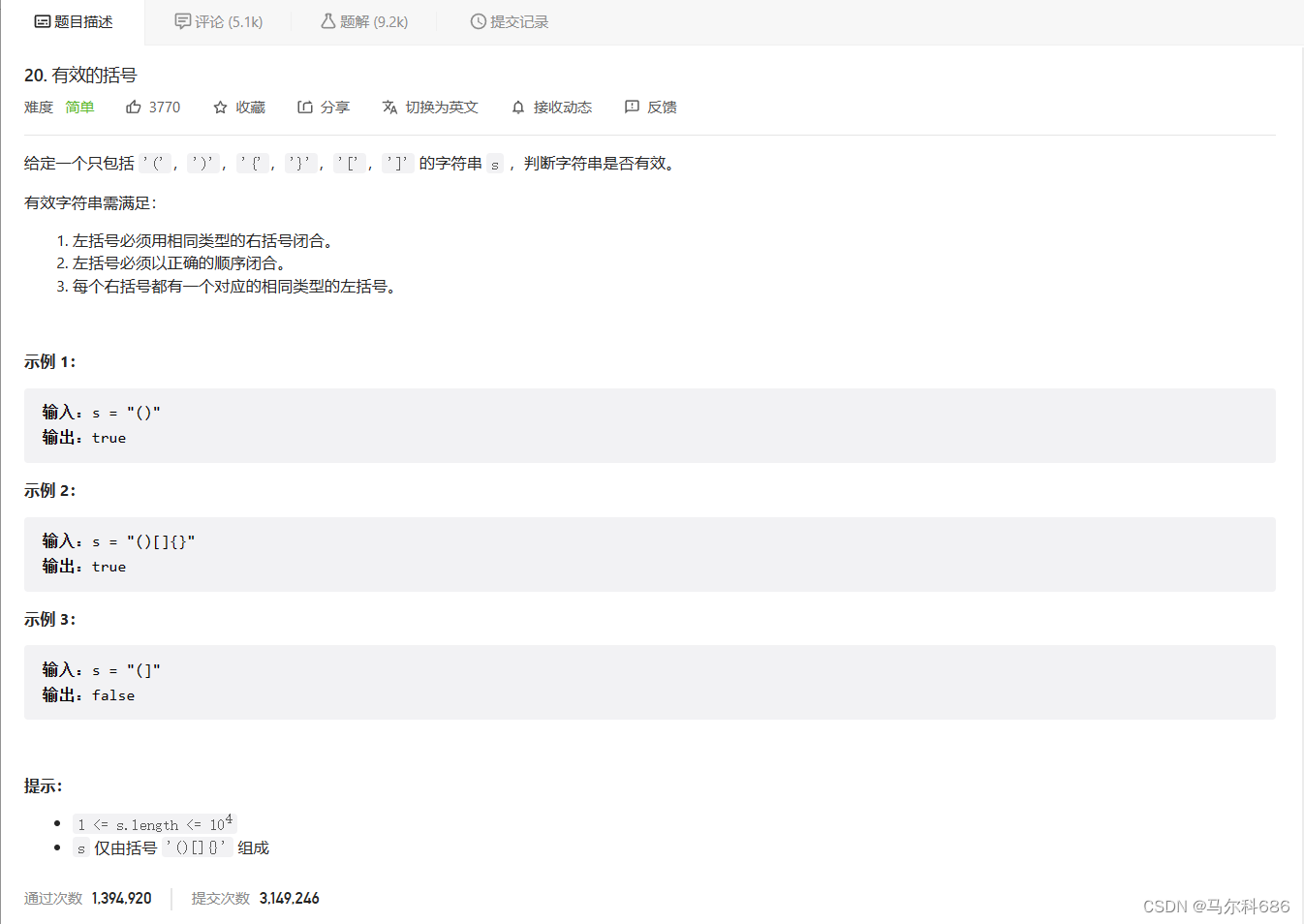
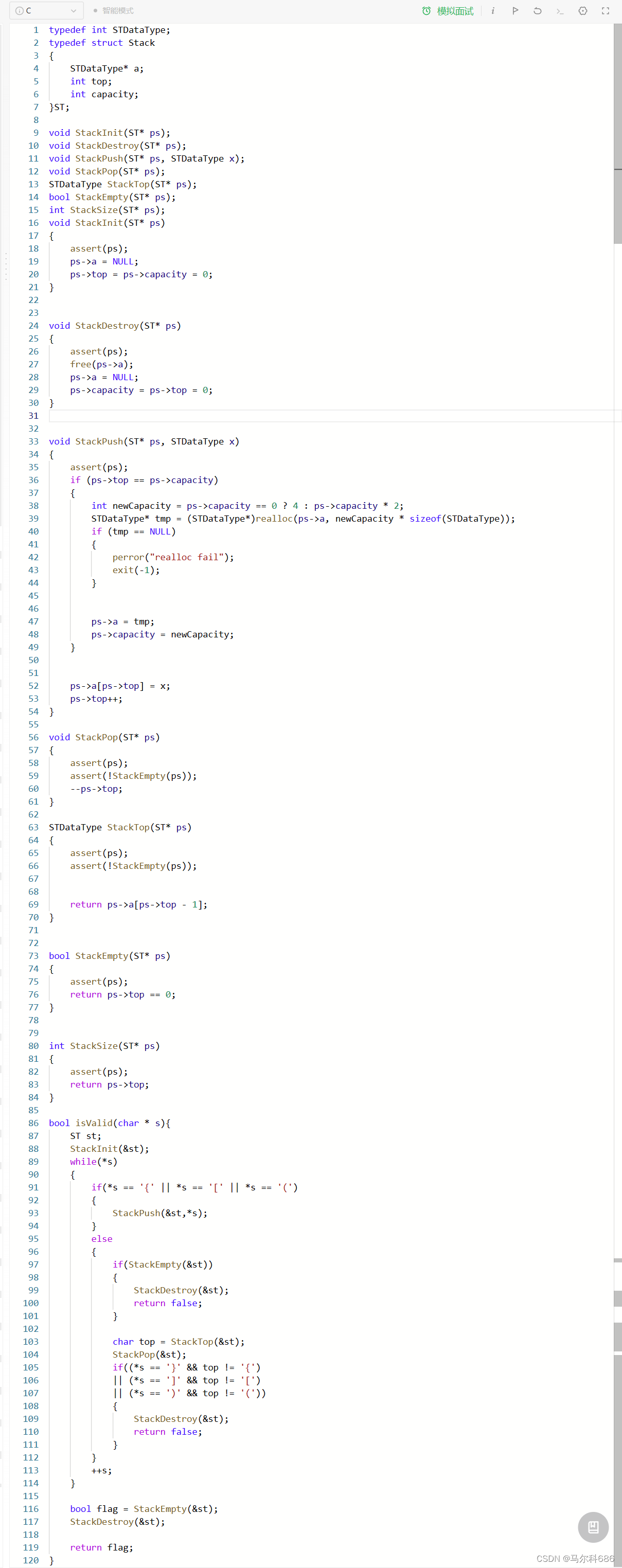
题目链接:
2.https://leetcode.cn/problems/implement-stack-using-queues/
